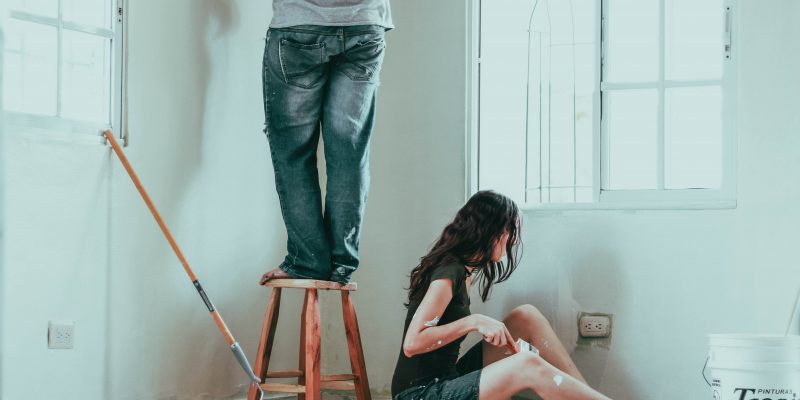Are you excited about transforming the look of your home with a fresh coat of indoor paint? Painting indoors can be a fun and rewarding experience, but it’s essential to take precautions to prevent accidents and protect your furniture.
Below, we’ll explore common accidents that can occur during indoor painting, discuss the potential consequences, and provide practical tips on how to avoid mishaps. Whether you’re a novice or an experienced painter, these guidelines will help you create a safe painting environment while safeguarding your precious furniture and delicate items.
Understanding Common Accidents While Painting Indoors
Accidents happen, but with a little awareness, we can minimize their occurrence. When it comes to indoor painting, there are a few common mishaps that can disrupt the process. One of the most common accidents is knocking over paint cans or brushes, which can lead to spills and splatters. Also, accidentally spilling paint on the floor or furniture can cause irreversible damage. Lastly, making contact with wet paint unintentionally can create smudges and smears on surfaces. These accidents can have significant consequences, including property damage, stubborn stains that are difficult to remove, and even personal injuries.
However, by at least knowing the potential consequences, we can take proactive measures to avoid them and ensure a smooth painting experience. Understanding the potential consequences of these accidents empowers us to take proactive measures to prevent them from happening. And by implementing a few simple strategies and remaining mindful throughout the painting process, you can create a safe and accident-free environment for your indoor painting project.
Ways to Avoid Accidents and Protect Furniture While Painting Indoors
1. Set clear rules and guidelines before starting the painting project
Before you begin painting, gather all participants and set clear rules to establish a calm and focused environment. Emphasize the importance of avoiding rough play and any actions that could lead to accidents near furniture. By communicating these guidelines, everyone involved in the project will be aware of the need for caution.
2. Prepare the painting area adequately
Proper preparation is key to avoiding accidents and protecting your furniture. Start by clearing the space of any obstacles, such as furniture or fragile items, to create a safe working environment. Pay extra attention to delicate bone inlay furniture, which requires special care. Cover furniture with protective materials, such as drop cloths or plastic covers, to prevent accidental spills or splatters from damaging the surfaces.
3. Assign specific roles and responsibilities
Assigning roles and responsibilities helps ensure a smooth workflow and minimizes the risk of accidents. Allocate tasks based on individuals’ abilities and experience. For example, someone with experience can handle delicate painting near furniture, while others can focus on less risky tasks. Define responsibilities clearly and everyone will understand their duties and be more cautious around furniture.
4. Use proper safety equipment
Equipping yourself and others with the right safety gear is essential for accident prevention. Wear goggles, gloves, and aprons to protect against spills and splatters. These items act as a barrier between you and the paint, reducing the risk of stains and skin irritations. On top of that, use drop cloths or plastic covers to catch paint drips and spills, especially near furniture, to prevent them from seeping onto delicate surfaces.
5. Encourage careful movement and awareness
Slow and deliberate movement is crucial to prevent accidents while painting indoors. Remind everyone involved to move cautiously, avoiding sudden motions near furniture. Emphasize the importance of being aware of their surroundings and the proximity of furniture and fragile items. When careful movement and awareness are fostered, you can prevent accidental collisions or spills that could damage furniture.
6. Take regular breaks
Fatigue can increase the likelihood of accidents, so encourage rest periods during the painting process. Use breaks to reiterate safety measures and assess progress. During these breaks, ensure furniture protection by checking for any spills or potential hazards nearby. Taking the time to rest and regroup not only reduces the risk of accidents but also allows for a more enjoyable painting experience.
7. Monitor and supervise the painting process
Designate someone responsible for overseeing the project and ensuring adherence to safety rules, particularly around furniture. This person can provide guidance, address any risky behaviour promptly, and remind everyone of the importance of caution and furniture protection. Regular monitoring and supervision create a safe and accountable environment for painting.
8. Encourage open communication
Create an environment where individuals feel comfortable voicing concerns or asking for help regarding furniture protection. Establish a clear channel for reporting accidents or near misses involving furniture. Encouraging open communication allows for quick resolution of issues and prevents further accidents. Plus, it fosters a sense of teamwork and shared responsibility for maintaining a safe painting environment.
9. Clean up spills immediately
Accidental spills are bound to happen, but it’s very important to address them promptly. Act swiftly to prevent accidents caused by slippery surfaces near furniture. Keep cleaning supplies readily available for a prompt response. By cleaning up spills immediately, you can minimize the risk of slips, falls, and further damage to furniture.
10. Reflect on the painting experience
Once the painting project is complete, take the time to reflect on the overall experience. Discuss lessons learned and areas for improvement, particularly in terms of furniture protection. Share your insights with others to help them avoid similar accidents and foster a safer painting environment. Reflecting on the experience not only promotes personal growth but also contributes to a community of safe painters.
Conclusion
Painting indoors is a fantastic way to transform your living space, but it’s crucial to prioritize safety and protect your furniture throughout the process. By understanding common accidents that can occur while painting, preparing the area adequately, assigning roles, using proper safety equipment, encouraging careful movement and awareness, taking regular breaks, monitoring the process, promoting open communication, cleaning up spills promptly, and reflecting on the experience, you can create a safe painting environment while safeguarding your furniture and delicate items. So, follow these guidelines, and enjoy a successful and accident-free painting adventure!




















